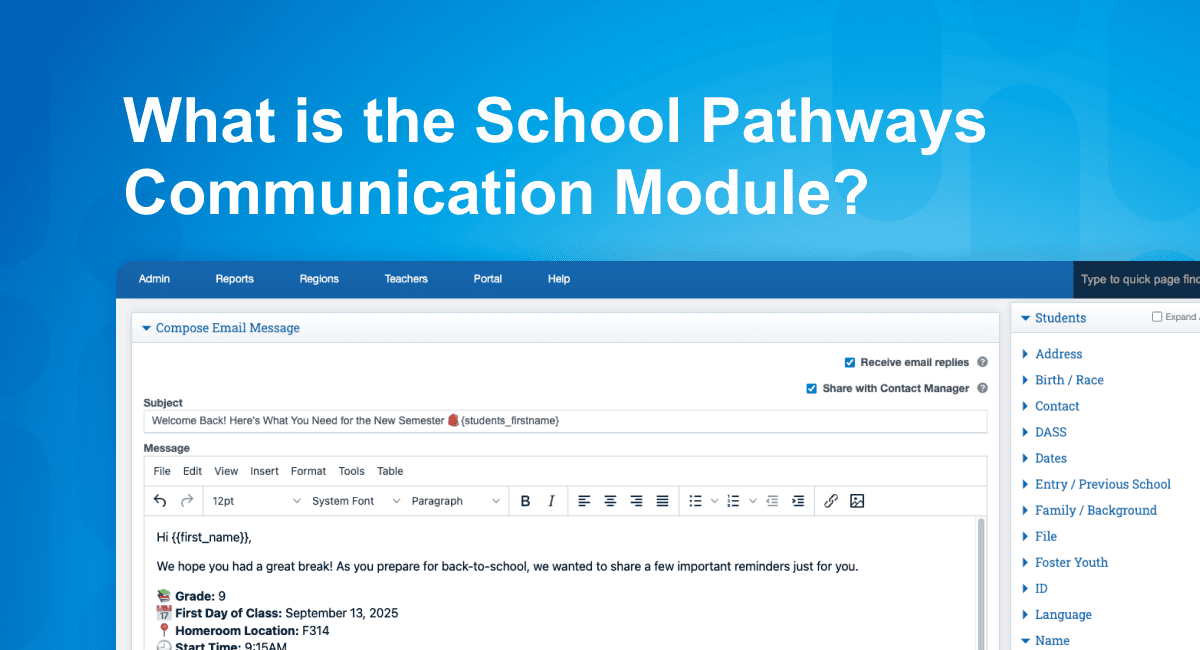Choosing the right school for a child is one of the most important decisions families will make. District schools offer tradition, while charters promise a fresh approach. But with academics, social environments, flexibility, safety, distance, and cost in the mix of considerations, it can feel overwhelming for families to navigate the world of school choice.
As Rick Hess, director of Education Policy Studies at the American Enterprise Institute, explains: “The last few years have been historic ones for the school choice movement. Dozens of new programs have been adopted, existing programs have been expanded, education savings accounts (ESAs) have morphed from an oddity into a legislative reality, and new school models have flourished.”
The growing complexity can leave families feeling overwhelmed and confused. As district or charter school educators, it’s important to offer informed, confident advice to help families navigate the maze of school choice options, eligibility requirements, and application processes. In this article, we’ll break down school choice and offer practical tips for educators on how to make the students’ school selection processes clear, accessible, and empowering for families.
What Is School Choice?
“School choice” is the term advocates use to describe “programs and policies that allow families to use public money to access schools beyond their local option.” This can include charters, private schools as well as hybrid, online, and homeschooling programs.
School choice has become a hot-button issue at the center of a larger debate about the quality and role of education. This debate has grown increasingly complex and politically charged as many states have enacted legislation supporting increased school choice.
Critics of these policies cite concerns over a range of issues. One major concern is that diverting funds from traditional public schools leaves them under-resourced, particularly impacting vulnerable student populations. Additionally, a lack of adequate oversight can create opportunities for misused funds and the establishment of low-quality schools.
On the other hand, advocates for school choice counter these criticisms with a focus on empowerment and opportunity. They argue that school choice allows families to make flexible education decisions that best suit their unique needs and values. They also believe this choice places a higher level of accountability on schools as they compete to serve families directly. Proponents see potential for increased equity as low-income and minority students gain access to schools they may not have otherwise had the option to attend.
While the debate about school choice will likely continue, most U.S. states have school choice programs. And as support for the approach continues to grow, families need to understand and navigate these realities.
Navigating School Choice Processes and Requirements
Educators can play a crucial role in guiding families by providing clear, up-to-date information to support informed decision-making. Let’s break down the process step-by-step, from exploring common school choice types to understanding its application and lottery process.
Types of School Choice Options
School choice can take many forms. While many people associate school choice with funding for private schools, the policies also support public school options.
- Charter Schools: These independently run public schools offer free enrollment and operate with more flexibility than traditional public schools.
- Magnet Schools: These public schools offer free enrollment and specialize in a particular focus or interest, such as STEM or the arts.
- Inter/Intra-District Choice: Some districts allow families to choose traditional public schools outside of their assigned zone (inter-district) or within their zone but at a different school (intra-district).
Private school options are often financially out of reach for many families, and school choice policies aim to offset some of these expenses through a range of options:
- Educational Savings Accounts (ESAs): These government-authorized accounts allow families to save money specifically for educational expenses, including private school tuition.
- Vouchers: In a voucher system, school district funds are allocated to participating families for private school tuition.
More innovative and less traditional methods of school choice offer even greater flexibility and personalization for families:
- Homeschooling: Each state has its own laws governing homeschooling options, but many include homeschooling options within their school choice legislation.
- Microschools: These small, often specialized schools often have highly specialized instruction focused on a specific topic or learning approach.
- Virtual Schools: With the rise of online learning, students have a wide range of virtual schooling options, opening up education without location restrictions.
Application Timelines & Requirements
Every school has varying application windows and requirements, and navigating school choice options requires an early start. Educators should outline when to begin the school search and process for submitting applications to help families make the most of their options.
Typically, the application process starts a full year before enrollment. Early decision applications are generally due in November with regular decision applications due in January or February. When space allows, many schools will accept applications throughout the year on a rolling basis. Admission decisions are typically announced in the spring with a May 1 commitment deadline.
It’s also important to note that some districts have centralized applications for multiple school choice programs, while others require applications directly to individual schools.
While the individual elements of the application vary, the basic requirements are typical:
- Student Demographic Information
- Parent/Guardian Information
- Residency Verification
- Transcripts from Previous Enrollments
- Test Scores
Charter schools or schools with specialized programs (STEM or visual and performing arts) may have additional application requirements, such as essays or written statements, auditions, interviews, and entrance exams.
Equitable Lottery Systems
Many school choice programs have limited seats. If applications exceed capacity, lotteries are often used to determine enrollment fairly. For many charter schools, a lottery selection process is a requirement. This lottery process is randomized, giving each applicant a chance of being selected. How a school randomizes its selection process can vary greatly. Some rely on computerized programs, while others prefer a traditional name drawing.
Within schools using a lottery system, priorities and preferences may exist. These preferences often aim to serve students with greater needs determined by specific criteria. For instance, siblings of current students or those living within specific geographic boundaries might receive preferential placement.
Failing to secure a spot during the lottery does not automatically mean an applicant cannot attend. Schools can implement a waitlist that will move through a randomized list of additional applicants if the chosen applicants decide not to enroll or fail to act on their acceptance.
The Role of Educators in Supporting Families
School leaders operating in a school choice educational landscape have responsibilities at every step in the process. From the moment a family expresses interest, through the application process, lottery draw, and even beyond, families will need guidance they can trust. Proactively providing these supports will allow schools to reduce stress, build trust, and help families navigate their options with confidence.
Educators who are dedicated to keeping families engaged and updated in the process should follow these best practices:
Have an Informative Website
To streamline enrollment and empower families, create a dedicated website or a comprehensive section on your existing school website. This hub should clearly outline school choice policies, eligibility requirements, and the entire application process. Emphasize crucial deadlines, required materials, and the lottery system (if applicable).
Waiting to hear back from schools can be a nerve-wracking time for families, especially for those on the waitlist. Create a positive experience by spelling out communication protocols and waitlist procedures to ensure that families can receive timely notifications. Include details like how you determine waitlist rankings, when families can expect communication and other important timelines.
Additionally, a robust FAQ section will preemptively answer common questions, providing additional clarity and support to prospective families.
Provide In-Person and Virtual School Tours
In-person tours aren’t just informational – they let families feel the energy of your school and provide valuable experiences for making informed decisions. Show prospective parents and students what sets you apart by offering personalized school tours and open houses.
Small group school tours during the day or student-led tours offer a unique perspective, while some families may prefer the buzz of a traditional open house. To effectively promote a school’s distinct opportunities, it’s worth highlighting specific areas of strength, such as a STEM tour, arts and culture tour, or other sessions showcasing your specialized programs. This is also the time to encourage families to ask questions and explore their priorities and children’s needs.
For families with busy schedules, consider hosting evening and weekend events to create flexibility. Virtual tours and webinars also provide online access for anyone to dive into your school’s unique offerings.
Enhance Accessibility in Materials and Tools
Every family deserves equal access to information. Your school can make an impact by providing communication tools with a focus on accessibility.
Think beyond English-only resources and incorporate translation services in the tools you’re using. Offering forms in multiple languages helps accommodate families from diverse backgrounds. Additionally, you can provide families with extra flexibility and offer online application submission through a mobile-friendly, online student application portal. This allows families to complete the process at their convenience, even without a desktop computer.
Implement an Efficient and Fair Lottery System
The lottery system is a crucial part of school choice. But a fair and well-managed lottery can be a big stress reliever for families.
Schools should implement a lottery system built on the pillars of fairness, equity, and transparency. This means utilizing a rules-based, randomized lottery system that runs with unbiased selection. Rather than dealing with error-prone, onerous, and time-consuming paper-based systems, schools using online systems can be confident in their data accuracy, family communications, and compliance.
With a configurable lottery system, educators can balance priorities and preferences while ensuring equitable access for all applicants. Additionally, automated lottery systems can simplify the application process for families by receiving status communications based on lottery results.
Empower Families With School Choice
School choice should operate to empower families and give them control over their educational options. It can only do that if educators provide clear, accurate, and accessible information for families to navigate the process of deciding and applying to the schools around them.
Using a dedicated application, lottery, and enrollment solution provides families the clarity and support they need while giving educators an easy system for managing their administrative duties. Interested in seeing the Application and Lottery System in action for yourself? Let’s chat.





